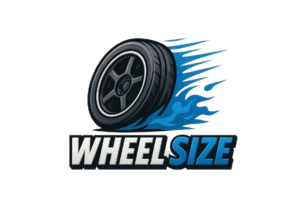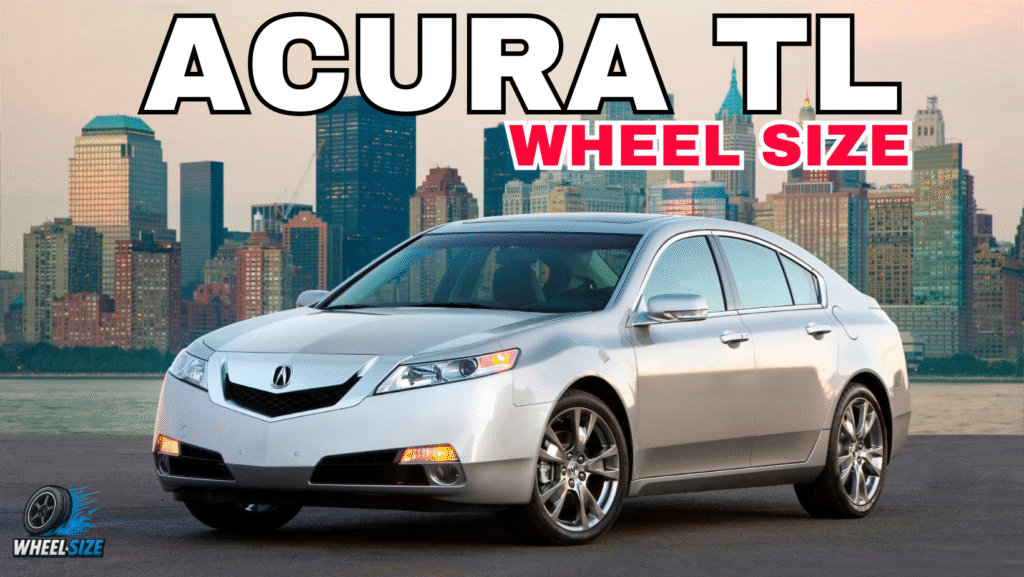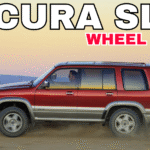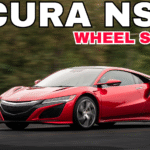The Acura TL is one of those sedans that never really goes out of style. Whether you’re rolling in a first-gen classic or a late-model TL with all the bells and whistles, your car deserves wheels that fit right—both for the look and the ride. The right wheels do more than fill the fenders; they set the tone for your TL’s stance, handling, and overall personality on the road. Mess up the specs, and you’re looking at rubbing tires, weird vibrations, or even safety issues. That’s why this guide is here—to take the guesswork out of wheel and tire choices for every Acura TL generation. Below, you’ll find easy-to-follow breakdowns for each model year, including all the nerdy details you need: bolt patterns, center bores, lug nuts, and tire sizes. We’ll also talk about what works (and what doesn’t) if you’re thinking of switching to aftermarket wheels. Ready to dial in your TL? Let’s get started.
Read About: Acura SLX Wheel Fitment Guide
Acura TL Generations Overview
Since its debut in the mid-’90s, the Acura TL has gone through some major changes—each generation bringing something fresh to the table. Early TLs wore smaller, more conservative wheels, while the latest models sported bolder designs and larger diameters. It’s not just about looks, either: each generation came with its own bolt patterns, hub bores, and recommended tire sizes, which means not every set of wheels fits every TL. From four-lug classics to modern five-lug monsters, the TL family has a fitment profile for every taste. This diversity is why knowing your generation is crucial before hitting “buy now” on those new wheels. In the sections below, you’ll find generation-specific specs and advice to make sure your next upgrade is as smooth as your TL’s V6. Whether you’re into subtle OEM+ upgrades or want to go big with aftermarket alloys, understanding your TL’s history sets the stage for a perfect fit.
Acura TL UA8/9 Facelift (2012–2014) Wheel & Tire Specs
With the 2012–2014 TL facelift, Acura dialed up both style and substance. These later TLs look sharp with aggressive lines and come standard with larger wheel options—making them a favorite for owners who want to add a personal touch. This generation moved to a five-lug, 5×120 bolt pattern, giving you plenty of aftermarket choices. The big fenders easily swallow 17″, 18″, or even 19″ wheels, with plenty of enthusiasts stepping up to 20″ or 22″ setups for that show-ready vibe. The key is nailing the offset and not going too wide, or you’ll run into clearance problems, especially if you’re lowered. Always double-check your center bore (64.1 mm is the ticket) and torque your lugs right to avoid wobbles. Whether you’re after daily comfort or head-turning presence, this TL has the bones to pull off just about any wheel setup you can imagine.
2012–2014 Acura TL UA8/9 Wheel & Tire Specs
| Year | Center Bore | Bolt Pattern | Lug Nut Thread | OEM Tire Size | OEM Rim Size | OEM Offset (mm) | Tire Pressure (bar) | Aftermarket Range |
| 2012–2014 | 64.1 mm | 5×120 | M14 x 1.5 | 245/50R17 98V | 8Jx17 ET55 | 53–57 | 2.3 / 2.3 | 20″–22″ |
| 2012–2014 | 64.1 mm | 5×120 | M14 x 1.5 | 245/45R18 96V | 8Jx18 ET55 | Not specified | 2.5 / 2.5 | 20″–22″ |
| 2012–2014 | 64.1 mm | 5×120 | M14 x 1.5 | 255/40ZR19 95W | 8.5Jx19 ET50 | Not specified | 2.5 / 2.5 | 20″–22″ |
OEM Wheel & Tire Specifications
Acura’s OEM setup for this TL is all about balance—sharp handling, ride comfort, and a design that fills the arches just right. The 17″, 18″, and 19″ stock wheels each bring their own flavor. The 19s look the most aggressive and give the car real presence without sacrificing ride quality. Lug nut thread is beefed up to M14 x 1.5 for more grip on the studs, and the 5×120 bolt pattern means you get access to a wide world of wheels, including many popular aftermarket styles. Pay attention to the offset: too aggressive, and you risk rubbing; too weak, and the wheels sit awkwardly inside the fenders. Whether you stick with OEM or upgrade, knowing these numbers keeps your TL driving right.
Aftermarket Fitment Guide
The facelifted TL is begging for a set of show wheels, and its wheel wells let you go big—20s and even 22s are possible with the right offset and tire size. Just don’t forget to check brake clearance if you’re swapping in something fancy. Stick to the 64.1 mm hub bore to avoid vibrations and use hub-centric rings if your wheels have a larger bore. An offset between +45 and +55 usually works great, but a quick fender check never hurts. Upgrading to lightweight alloys or staggered setups can change the feel and look of your TL, but keep it within reason for daily drivability. Always test-fit before mounting tires for good measure.
Acura TL UA8/9 (2009–2011) Wheel & Tire Specs
If you own a 2009–2011 TL, you’re already sitting pretty on one of Acura’s sportiest sedans. This gen ushered in bigger brakes and more muscular lines, so the wheels had to step up, too. With a factory bolt pattern of 5×120 and a robust M14 x 1.5 thread, you’ve got the basics locked down for strength and performance. Acura gave these cars 17″, 18″, and 19″ factory options, with offsets engineered for a blend of agility and stability. Whether you’re rolling on stock alloys or eyeing some aftermarket designs, the key to success is understanding your offset range and how wider wheels will affect your stance. Get that wrong, and you could be dealing with rubbing issues or a ride that feels off. Below you’ll find the exact specs you need to dial in your wheel and tire choices.
2009–2011 Acura TL UA8/9 Wheel & Tire Specs
| Year | Center Bore | Bolt Pattern | Lug Nut Thread | OEM Tire Size | OEM Rim Size | OEM Offset (mm) | Tire Pressure (bar) | Aftermarket Range |
| 2009–2011 | 64.1 mm | 5×120 | M14 x 1.5 | 245/50R17 98V | 8Jx17 ET55 | 53–57 | 2.3 / 2.3 | 20″–22″ |
| 2009–2011 | 64.1 mm | 5×120 | M14 x 1.5 | 245/45R18 96V | 8Jx18 ET55 | Not specified | 2.5 / 2.5 | 20″–22″ |
| 2009–2011 | 64.1 mm | 5×120 | M14 x 1.5 | 255/40ZR19 95W | 8.5Jx19 ET50 | Not specified | 2.5 / 2.5 | 20″–22″ |
OEM Wheel & Tire Specifications
For these model years, Acura focused on making the TL handle as confidently as it looked. The 17-inchers are perfect for a smooth, everyday drive, while the 18s and 19s cater to those craving a bit more sportiness. Tire profiles get lower as the diameter increases, keeping your speedometer happy while making sure the overall wheel height stays close to stock. The factory offsets ensure plenty of clearance for suspension and fenders, but if you plan to change up your wheels, double-check those numbers to stay out of trouble. This spec sheet should be your best friend whether you’re swapping for new OEMs or starting your aftermarket adventure.
Aftermarket Fitment Guide
The TL from these years is a favorite for custom wheel projects. Thanks to its roomy arches and beefy hardware, you can run 20-inch wheels without major headaches—just keep the offset tight to factory for best results. Upgrading to wider wheels will amp up your stance, but watch out for rubbing on the inner fender. Many enthusiasts opt for an offset in the +45 to +55 range for that perfect flush look. If you’re after something wild, staggered fitments can work, but be mindful of your AWD or FWD layout to keep handling in check. A set of quality hub-centric rings is always a smart move if your aftermarket wheels aren’t a perfect fit.
Acura TL UA6/7 (2004–2008) Wheel & Tire Specs
The 2004–2008 TL is where things really started to heat up for Acura fans. These years marked a jump to a 5×114.3 bolt pattern—one of the most popular sizes out there, giving you an endless range of wheel choices. With a slightly smaller M12 x 1.5 lug thread and a center bore still at 64.1 mm, these TLs are straightforward when it comes to wheel swaps. Factory wheels ranged from sporty 17-inchers to aggressive 19s on later trims, all with offsets engineered to keep your handling tight. This TL is all about blending performance with luxury, so any changes to wheel size or width should stay in harmony with that original spirit. If you’re looking to upgrade, you’ve got more aftermarket options here than almost any other TL generation—just keep the offset and width in check to preserve that legendary Acura balance.
2004–2008 Acura TL UA6/7 Wheel & Tire Specs
| Year | Center Bore | Bolt Pattern | Lug Nut Thread | Torque (Nm) | OEM Tire Size | OEM Rim Size | OEM Offset (mm) | Tire Pressure (bar) | Aftermarket Range |
| 2004–2008 | 64.1 mm | 5×114.3 (5×4.5) | M12 x 1.5 | 108 | 235/45ZR17 93W | 8Jx17 ET45 | 43–47 | 2.3 / 2.3 | 19″–20″ |
| 2004–2008 | 64.1 mm | 5×114.3 (5×4.5) | M12 x 1.5 | 108 | 235/40ZR18 92W | 8Jx18 ET45 | Not specified | 2.3 / 2.3 | 19″–20″ |
| 2004–2008 | 64.1 mm | 5×114.3 (5×4.5) | M12 x 1.5 | 108 | 245/35ZR19 91Y | 8.5Jx19 ET50 | Not specified | 2.5 / 2.5 | 19″–20″ |
OEM Wheel & Tire Specifications
The stock wheels for this TL strike a great balance—plenty of sidewall for daily comfort, yet sporty enough to handle a quick backroad run. Acura engineered these cars with a medium-high offset, keeping everything tucked neatly under the fenders and away from suspension bits. The 5×114.3 bolt pattern opens up a ton of options, making it easy to find both factory and aftermarket wheels. Always match the center bore and use the recommended torque (108 Nm) to keep things safe and tight. Stick with recommended tire pressures for the best ride and longest tire life.
Aftermarket Fitment Guide
This TL is a dream for wheel swappers, and its chassis handles upsized wheels with ease. Most owners find that 19s are the sweet spot for looks and ride comfort, though 20s work if you’re after that big-wheel vibe. If you’re chasing perfect fitment, aim for an offset close to +45 for an OEM-like stance. You can go wider for a more aggressive look, but don’t overdo it—too much width or too low an offset can cause rubbing, especially if you’re lowered. Always test fit and check for full suspension travel clearance before mounting tires.
Acura TL UA4/5 (1999–2003) Wheel & Tire Specs
Stepping into the 1999–2003 TL, you’re driving a model that blends classic Acura luxury with subtle sporty cues. This generation features a 5×114.3 bolt pattern and M12 x 1.5 lug threads, just like its successor, but with slightly narrower factory wheels. Center bore remains 64.1 mm for easy swaps, and the recommended torque keeps things secure. OEM wheels for this TL start at 16 inches and top out at 18s, with tire profiles tailored for comfort. Upgrades are straightforward, thanks to the common bolt pattern, but offset and width choices should stay close to stock unless you’re ready to roll fenders. With the right wheel choice, you can keep this TL cruising comfortably or transform it into a sleeper with just the right touch of custom flavor.
1999–2003 Acura TL UA4/5 Wheel & Tire Specs
| Year | Center Bore | Bolt Pattern | Lug Nut Thread | OEM Tire Size | OEM Rim Size | OEM Offset (mm) | Tire Pressure (bar) | Aftermarket Range |
| 1999–2003 | 64.1 mm | 5×114.3 (5×4.5) | M12 x 1.5 | 205/60R16 91V | 6.5Jx16 ET55 | 53–57 | 2.1 / 2.1 | 18″–20″ |
| 1999–2003 | 64.1 mm | 5×114.3 (5×4.5) | M12 x 1.5 | 215/50R17 89V | 6.5Jx17 ET55 | Not specified | 2.3 / 2.3 | 18″–20″ |
| 1999–2003 | 64.1 mm | 5×114.3 (5×4.5) | M12 x 1.5 | 215/45R18 89V | 7Jx18 ET50 | Not specified | 2.5 / 2.5 | 18″–20″ |
OEM Wheel & Tire Specifications
Factory wheels for these years focus on smooth rides and a touch of sportiness. With narrower widths and higher offsets, they tuck in nicely for daily driving. The bolt pattern matches other Honda/Acura models of the era, making cross-shopping for OEM wheels a breeze. Stick with recommended tire sizes and pressure for best results, and always match the lug nut thread and torque. These specs keep your TL’s ride buttery smooth while preserving the longevity of your suspension.
Aftermarket Fitment Guide
Going aftermarket with this TL is easy, but subtlety is key. The fender wells aren’t huge, so sticking close to the OEM width and offset is wise for trouble-free fitment. Eighteens look great and give you room for a slightly wider tire if you want more grip. Avoid super aggressive offsets or extra-wide wheels—unless you’re cool with rolling fenders or running camber. Always check your clearance at full lock and compression to dodge any unpleasant surprises.
Acura TL UA1/3 (1995–1998) Wheel & Tire Specs
If you’re cruising in an early TL, you’ve got something special. These cars rock a 4×114.3 bolt pattern and a 64.1 mm center bore—something you don’t see much anymore. Factory wheel sizes are modest, topping out at 17s, but this means you get a plush ride and classic Acura looks. Lug nuts are M12 x 1.5, matching most Honda/Acura models of the day. The high offset keeps everything snug inside the arches, so upgrades need to be measured and smart. These cars reward owners who respect their classic vibe; stick close to recommended sizes for a setup that works day in, day out.
1995–1998 Acura TL UA1/3 Wheel & Tire Specs
| Year | Center Bore | Bolt Pattern | Lug Nut Thread | OEM Tire Size | OEM Rim Size | OEM Offset (mm) | Tire Pressure (bar) | Aftermarket Range |
| 1995–1998 | 64.1 mm | 4×114.3 (4×4.5) | M12 x 1.5 | 205/60R15 91H | 6Jx15 ET55 | 53–57 | 2.1 / 2.1 | 17″–18″ |
| 1995–1998 | 64.1 mm | 4×114.3 (4×4.5) | M12 x 1.5 | 205/55R16 89H | 6.5Jx16 ET55 | Not specified | 2.3 / 2.3 | 17″–18″ |
| 1995–1998 | 64.1 mm | 4×114.3 (4×4.5) | M12 x 1.5 | 215/55R16 91H | 6.5Jx16 ET55 | Not specified | 2.3 / 2.3 | 17″–18″ |
| 1995–1998 | 64.1 mm | 4×114.3 (4×4.5) | M12 x 1.5 | 215/45R17 89V | 7Jx17 ET50 | Not specified | 2.5 / 2.5 | 17″–18″ |
OEM Wheel & Tire Specifications
These early TLs keep things simple. Factory wheels are on the smaller side, but they fit the car’s classic proportions perfectly. The 4-lug pattern makes aftermarket wheel shopping a little more specific, so double-check compatibility before you buy. Stick with original specs for the best ride and keep that Acura DNA intact. If you’re looking to upgrade, make sure your new wheels have the right center bore or use quality hub-centric rings to keep things smooth.
Aftermarket Fitment Guide
With the unique 4×114.3 pattern, choices are a bit more limited, but there are still great options out there. Seventeens look just right, adding a modern touch without overdoing it. If you want to push the envelope, eighteens can fit, but stay close to factory offset and width. Watch your fender clearance and don’t forget that classic cars deserve classic attention to detail—don’t cut corners when it comes to fitment.
How to Choose the Right Aftermarket Wheels for Your Acura TL
Picking out aftermarket wheels isn’t just about what looks cool—it’s about dialing in the perfect blend of style, function, and fit. First off, always confirm your bolt pattern and center bore so everything lines up without drama. Next, choose your wheel size with care: bigger isn’t always better for daily driving, though it can seriously change your car’s vibe. Offset is your friend—go too aggressive, and you’ll be rubbing fenders; too conservative, and your wheels will hide inside the arches. Brands like Enkei, Konig, and XXR are popular for good reason—they balance price, weight, and style in all the right ways. If you’re chasing that perfect stance, test fit your wheels before mounting tires. And if you’re unsure, reach out to fellow TL owners—there’s a whole community out there that’s happy to share what works.
Acura TL Wheel Fitment FAQ
What’s the bolt pattern for the Acura TL?
It depends on the year. Early TLs (1995–1998) use a 4×114.3 pattern, while later generations (1999–2014) step up to 5×114.3 or 5×120. Always double-check before buying wheels.
Can I run bigger wheels than stock?
Absolutely—most TLs can handle one or two inches larger than factory, as long as you keep the offset and tire diameter in check. Just remember, bigger wheels mean lower-profile tires and a firmer ride.
Will Honda or other Acura wheels fit my TL?
Many will, but only if the bolt pattern, offset, and center bore match. Honda’s 5×114.3 wheels are a common swap for mid-2000s TLs, but always confirm specs first.
Do I need hub-centric rings for aftermarket wheels?
If your new wheels have a larger center bore than your TL’s hub, yes. Hub-centric rings prevent vibration and keep your ride smooth.
Conclusion
Upgrading your TL’s wheels is one of the best ways to add a personal touch and boost performance. Armed with the info above, you can shop with confidence—knowing exactly what fits and what doesn’t, no matter which generation you’re driving. Bookmark this guide, check your specs, and take your time picking the perfect set. And if you’ve found a killer fitment or have questions, don’t be shy—join the community, share your setup, and help the next enthusiast get it right.



